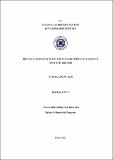Please use this identifier to cite or link to this item:
http://hdl.handle.net/11547/2308Full metadata record
| DC Field | Value | Language |
|---|---|---|
| dc.contributor.author | Tosun, Oğuzhan | - |
| dc.date.accessioned | 2019-05-29T06:31:09Z | - |
| dc.date.available | 2019-05-29T06:31:09Z | - |
| dc.date.issued | 2017 | - |
| dc.identifier.uri | http://hdl.handle.net/11547/2308 | - |
| dc.description.abstract | Dünya hızlı bir şekilde yenilenebilir enerji kaynağı kullanımına geçmektedir. Özellikle son yıllarda bu konuda yatırımlarında artması yenilenebilir enerjinin önemini göstermektedir. Rüzgâr enerjisi de son zamanlarda göstermiş olduğu gelişimlerle çokça bahsedilen yenilenebilir bir enerji çeşididir. Rüzgâr enerjisi, rüzgâr türbin makineleri vasıtasıyla ilk önce mekanik, daha sonra elektrik enerjisine dönüştürülür. Üretilebilecek enerji miktarını etkiyen en önemli faktörler; rüzgâr türbini bıçak sayısı ve bıçak yapısı, türbin tasarımı, dişli yapısı kısacası sistemin her bir faktörü üretilecek enerji miktarını etkilemektedir. Bu yüzden her yıl rüzgâr türbini ile ilgili yatırım miktarları da artmaktadır. Rüzgâr enerjisinde ilk sermaye yatırımı makine ve destekleyici altyapı için kullanılmaktadır. Türbin tasarımı, tesisin kurulumu ve işletilmesi gibi enerji maliyet fiyatının artmasına sebep olan faktörler rüzgâr gücünü bir alternatif enerji kaynağı yapma anahtarıdır. Bir rüzgâr türbinin matematiksel modellenmesi, işlem alanı üzerinde, rüzgâr türbinin davranışının anlaşılması için gereklidir. Çünkü rüzgâr türbinin optimum değerlerde çalışmasına yardımcı olacak kapsamlı kontrol algoritmaların geliştirilmesine izin verir. Modelleme, rüzgâr türbini performans değerlerinin kontrol edilmesini sağlar. Model sonuçları, türbin tasarımını optimize etmek ve rüzgâr enerjisi fiyatının artmasına yol açacak faktörleri minimize etmek isteyen yeni nesil türbin araştırmacıları ve tasarımcıların yararlanabileceği bir bilgi olacaktır. Bu tezde rüzgâr enerji sistemleri üzerinde çalışılmış ve rüzgâr türbin sisteminin matematiksel modellemesi yapılmıştır. Çevre şartları ve rüzgâr türbini için belli parametreler dikkate alınarak simülasyonlar gerçekleştirilmiştir. Uygulamalı görmek için mini rüzgâr türbini imal edilmiştir. | tr_TR |
| dc.language.iso | tr | tr_TR |
| dc.publisher | İSTANBUL AYDIN ÜNİVERSİTESİ FEN BİLİMLERİ ENSTİTÜSÜ | tr_TR |
| dc.subject | Rüzgâr hızı | tr_TR |
| dc.subject | Türbin gücü | tr_TR |
| dc.subject | Güç katsayısı | tr_TR |
| dc.subject | Uç hız oranı | tr_TR |
| dc.subject | Jeneratör | tr_TR |
| dc.subject | Enerji | tr_TR |
| dc.subject | Wind speed | tr_TR |
| dc.subject | Turbine power | tr_TR |
| dc.subject | Power factor | tr_TR |
| dc.subject | Top speed ratio | tr_TR |
| dc.subject | Generator | tr_TR |
| dc.subject | Energy | tr_TR |
| dc.title | BİLGİSAYAR DESTEKLİ 1 KW’ LIK RÜZGÂR TÜRBİNİ TASARIMI VE PROTOTİP ÜRETİMİ | tr_TR |
| dc.type | Thesis | tr_TR |
| dc.description.abstractol | The World is increasingly going renewable energy source. Especially in recent years, increase of the investments in this field shows the importance of renewable energy. Wind energy is the type of renewable energy that has been mentioned a lot in recent times. Wind energy is first converted to mechanical, then electrical energy by means of wind turbines. The most important factors affecting the amount of energy that can be produced are; the number of wind turbine blades and blade structure, turbine design, gear structure in short, each factor of the system affects the amount of energy to be produced. That’s why the investment related to the wind turbine increases every year. The first capital investment in wind energy is used for machinery and supporting infrastructure. Factors that increase the energy cost price, such as turbine design, installation and operation of the plant, are the key to making wind power an alternative energy source. Mathematical modeling of a wind turbine is necessary for understanding the behavior of the wind turbine on the process area. Because the wind allows the development of comprehensive control algorithms to help the turbine operate at optimum values. The modeling ensures that wind turbine performance values are controlled. Model results will provide information that can be used by next-generation turbine researchers and designers to optimize turbine design and minimize the factors that lead to increased wind energy costs. In this thesis, wind energy systems have been studied and mathematical modeling of the wind turbine system has been done. Simulations have been carried out by considering certain parameters for environmental conditions and wind turbine. Prototype wind turbine has been manufactured to see it applied. | tr_TR |
| dc.publisher.firstpagenumber | 1 | tr_TR |
| dc.publisher.lastpagenumber | 129 | tr_TR |
| Appears in Collections: | Tezler -Thesis | |
Files in This Item:
| File | Description | Size | Format | |
|---|---|---|---|---|
| 501502.pdf | 7.6 MB | Adobe PDF |  View/Open |
Items in DSpace are protected by copyright, with all rights reserved, unless otherwise indicated.
